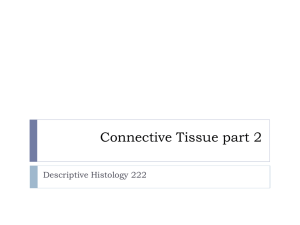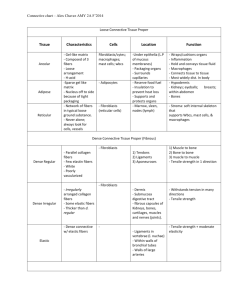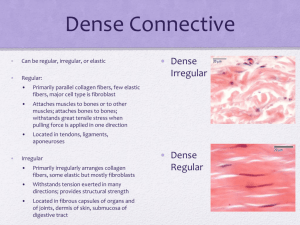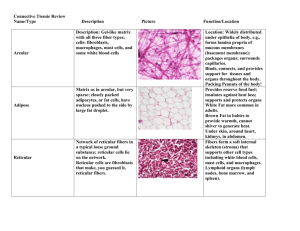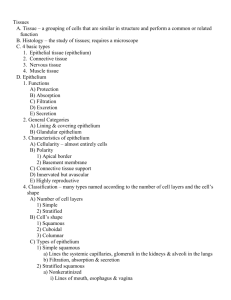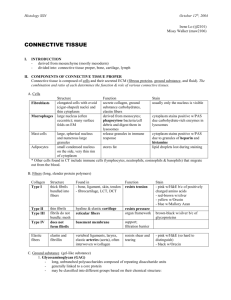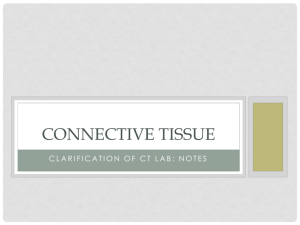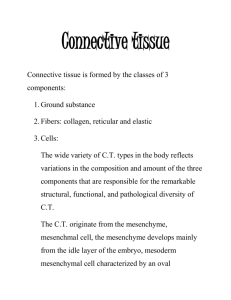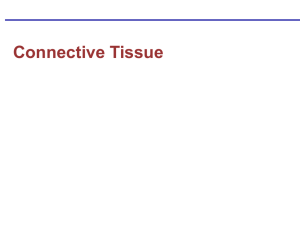Connective Tissue part 2
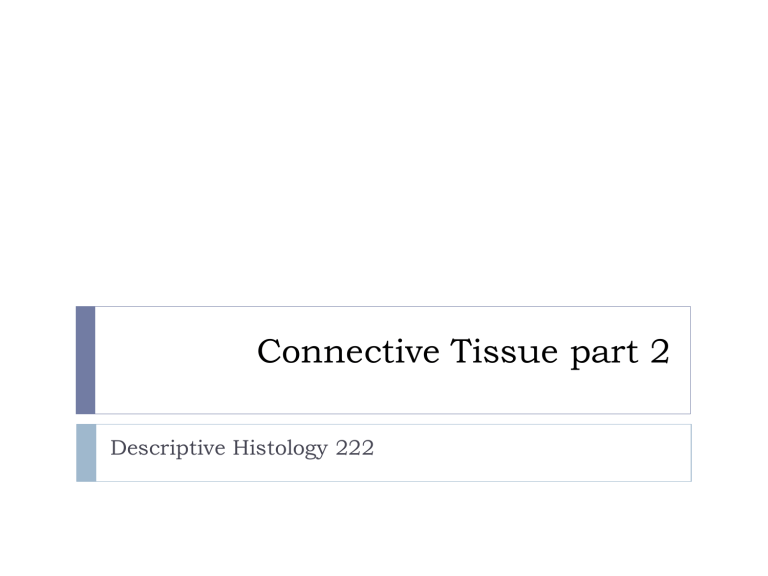
Connective Tissue part 2
Descriptive Histology 222
Fibers of connective tissue
Collagen fibers present main tensile strength, and are the stuff of scars.
Elastic fibers present elasticity.
Reticular fibers (really, a special form of collagen) provide a delicate supporting framework for loose cells.
Collagen fibers
Collagen types I, II and III are the major fibrous collagens
Type I collagen is the most abundant structural component of skin, tendons and bones. It represents 90 % of the total collagen content.
Type II makes the structural framework of cartilage and intervertebral disks.
Collagen fibers
Type III is present in many tissues: 1 to 2 % in tendons, 10
% in the skin and even 50 % in the vascular system
Type IV is the structural framework of the non-fibrous basement membranes which act as an underlying support for epithelial and endothelial cells, a protective sheath for myofibrils and the filtration membrane of the glomeruli
Elastic fibers
Elastin is another fibrous protein.
As the name suggests, elastin is elastic.
In ordinary connective tissue, elastic fibers help restore normal shape after distortion.
Elastic fibers can deteriorate with age and exposure to sun
Reticular fibers
Made from type III collagen, provide a very delicate network (hence the name) supporting individual cells in certain organs (lymph nodes, spleen, liver).
Reticular fibers do not show up in routine H&E stained specimens, but they can be demonstrated with silver salts.
Supportive Connective Tissue
CARTILAGE
Jelly-like matrix (chondroitin sulfate) containing collagen and elastic fibers and chondrocytes surrounded by a membrane called the perichondrium.
Unlike other CT, cartilage avascular (has NO blood vessels) or nerves except in the perichondrium.
The strength of cartilage is due to collagen fibers and the resilience is due to the presence of chondroitin sulfate.
Chondrocytes occur within spaces in the matrix called lacunae.
Supportive Connective Tissue
1.
2.
3.
Hyaline cartilage
Fibrocartilage
Elastic cartilage
Supportive Connective Tissue:
1.
Hyaline Cartilage (most abundant type) fine collagen fibers embedded in a gel-type matrix. Occasional chondrocytes inside lacunae.
Found in embryonic skeleton, at the ends of long bones, in the nose and in respiratory structures.
Function= flexible, provides support, allows movement at joints
Supportive Connective Tissue:
2.
Fibrocartilage
contains bundles of collagen in the matrix that are usually more visible under microscopy.
Found in the pubic symphysis, intervertebral discs, and menisci of the knee.
Function = support and fusion, and absorbs shocks.
Supportive Connective Tissue:
3. Elastic Cartilage
threadlike network of elastic fibers within the matrix.
found in external ear, auditory tubes, epiglottis.
function = gives support, maintains shape, allows flexibility
perichondrium (P)
Bone
Osteocytes (Gr. osteon, bone + kytos, cell), which are found in cavities ( lacunae ) between layers (lamellae) of bone matrix
Osteoblasts ( osteon + Gr. blastos, germ), which synthesize the organic components of the matrix
Osteoclasts ( osteon + Gr. klastos, broken), which are multi-nucleated giant cells involved in the resorption and remodeling of bone tissue.

